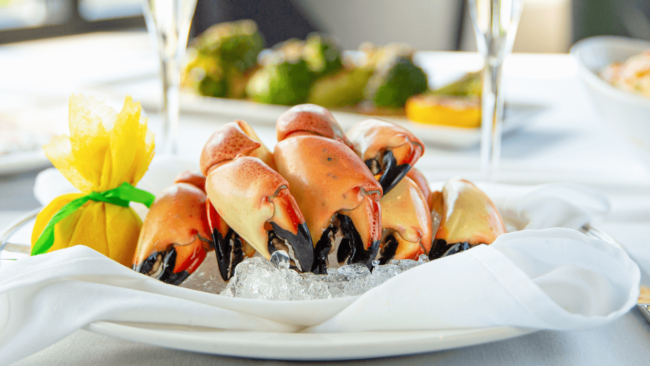10 Fun Facts About Florida Stone Crab
- Menippe mercenaria is the scientific name for Florida stone crab
Two species of stone crabs exist in the Southeastern United States: Menippe mercenaria in the peninsula of Florida, and Menippe adina in the northern and western Gulf of Mexico.
- 98% of stone crabs come from Florida
Yeah, you read that right—98%! We’re fortunate to partner with amazing crabbers in Florida that supply us with tasty, fresh stone crab daily.
- Stone crabs are a sustainable source
The crabbers in Florida are incredibly protective of the species and only the claws are harvested, preserving the life of the crab. Their claws pop off and regrow, like a lizard’s tail. Stone Crabs have two killer claws, allowing them to both feed and protect themselves while the missing claw grows back.
- Only the claws are harvested, and they must be at least 2¾” in length
An important part of sustainable Stone Crab is preserving the life of the crab, as well as adhering to strict requirements of claw length that allow for the crab to fully regenerate, as well as continually protect itself.
- Female stone crabs can lay up to one million eggs in one sitting
Crabbers are very protective of stone crab, but this especially applies to females because of their incredible reproductive power. One female stone crab can produce millions upon millions of eggs throughout their lifetime.
- Catching stone crabs
The Florida stone crab is usually fished near jetties, oyster reefs or other rocky areas, just as for blue crabs. Claws are sold by size, generally in four sizes: medium, large, jumbo, and colossal.
- Females live longer than males
Experts estimate that female stone crabs can live up to eight or nine years, while male stone crabs live up to seven or eight years. Males generally grow bigger than females and have a more variable rate of growth.
- Stone crabs only have a few predators
The primary natural predator of these crabs is the octopus which can restrain a crab’s claws with its tentacles and bite into the hard exoskeleton with its beak. Other predators include the Florida horse conch, black salmon, sea turtles, groupers, and humans.
- Eating habits
Florida stone crabs prefer to feed on oysters or small mollusks, bristle worms, and other crustaceans. They occasionally eat seagrass and carrion too. Meat that doesn’t fill the shell means there were predators in the water or a storm decreasing the crabs visibility. The crab will hide until it feels safe to come out and it will not eat until then. The trap was likely its first meal once it felt secure—hence the meat shrinks until it is well-fed again.
- 325,000 claws
That’s how many fresh Florida stone crab claws we capture, prepare, and serve to our guests each year during the season, October 15 through May 1.
The number of frozen Florida stone crab claws we serve our guests will always be ZERO. We 100% guarantee our stone crab claws are fresh and ethically prepared with our sustainable approach. Your table is waiting.



 OCEAN'S FINEST SEAFOOD & CRAB
OCEAN'S FINEST SEAFOOD & CRAB

